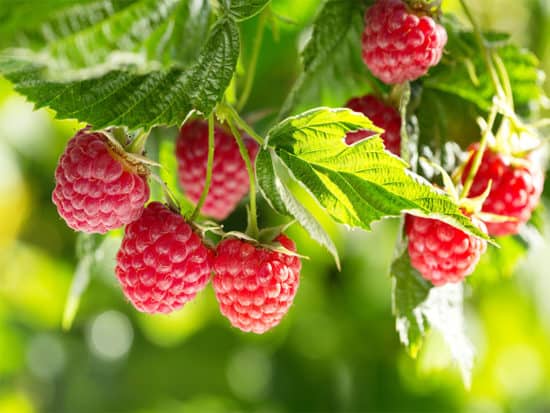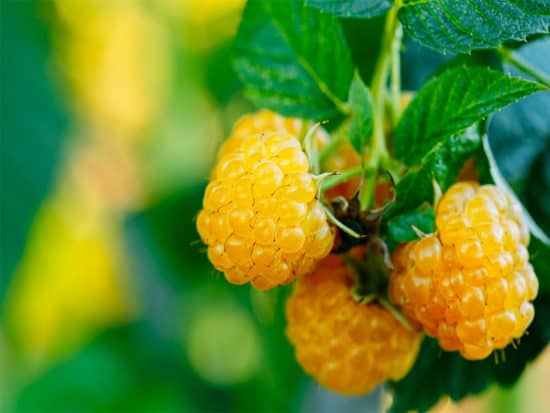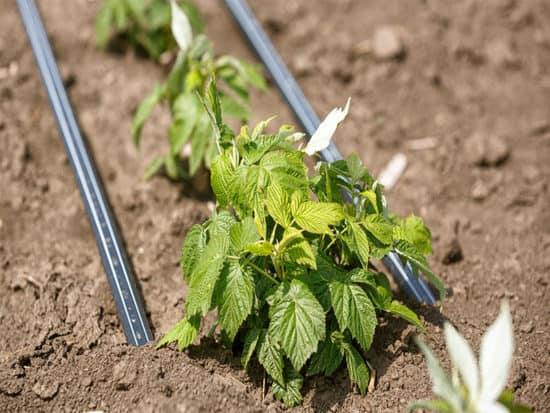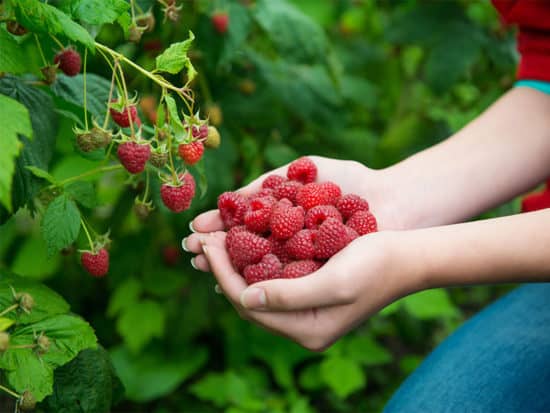How to Plant
Knowing how to plant, grow, and harvest raspberries can be very beneficial to just about anyone. It is not only that they look quite nice, but they are also very tasty and can be used in many meals.
To add to that, there are so many health and medicinal advantages to these little fruits, you should definitely start consuming them daily if you are not doing so right now.
Raspberries were not always this popular, back in the day, no one knew the many advantages that they can offer. However, with recent research showing just how amazing these fruits are, people from all over the world have started growing them.
If you want to start growing raspberries, then continue reading to learn more valuable information.

Ripe Raspberries on a Branch:
Interesting Facts About Raspberries
Raspberries are known as one of the most delicious fruits that exist. They can be grown in gardens, but they often grow in the wild as well. Harvesting them is very easy, but they do not last long after being harvested.
It is best to eat the raspberries a couple of days after they have been harvested. If not, you should consider freezing them because they might go from ripe to overripe quite fast.
Raspberry is a name most commonly used for small red fruits, but what many people do not know is that they can also be black, yellow-gold, and even purple.
They are also divided into two groups considering their harvest time. Some are harvested in the summer, while others are harvested in the fall.
If you are considering planting some raspberries, try to find representatives from the two harvesting groups so that you will have fresh raspberries available to you for a longer period.

A Bucket of Berries:
Best Growing Conditions for Raspberries
Before you get to the planting, you should probably learn more about the conditions that raspberries require. These are important facts that I will go over to get you ready to plant your raspberries.
Sunlight Helps Them Grow
When planting raspberries, make sure that they are in full sun for as long as possible. If you plant them in shade, they may take much longer to grow.
Another thing to take into consideration is that raspberries like to have air circulation but should not be planted in a place where there is constant wind.
Placement in Garden
When planting raspberries, make sure that the location has not been planted with the same fruits in the past years. Some diseases like Verticillium wilt might stay in the ground for several years after affecting the last raspberries.
If you plant new ones in that place, they may be affected by this disease as well. Also, do not plant new raspberries where other tomatoes, peppers, potatoes, eggplants, bramble berries, or roses were grown.
Type of Soil
When talking about soil, I would like to mention that raspberries can benefit from well-drained soil that is also loamy. They also benefit from organic matter that can be added to the soil while they do not require a lot of water.
Pay attention to the amount of water you give them because overwatering them can cause them to rot.
As for the pH level of the soil, it should not be below 5.5 as it should also not exceed 6.5. To add to that, you should acidify the alkaline soil if you do not want the raspberries to get lime-induced chlorosis.
If you are planning on planting them in sandy soil, you should add a lot of fertilizer to give them enough moisture.
What Kind of Raspberries Should You Plant?
As I have already mentioned, raspberries come in several colors. These different colored raspberries have different characteristics, some are sweet while others are not as much. Some are grown in summer and others during the fall.
When it comes to the raspberries that grow in the summer, I can mention the purple, red, and black raspberries as representatives of the group. As for the ones that grow in the fall, I will mention the yellow or gold ones.
Knowing which type of raspberries you are growing is very important as the ones that grow during the summer get to fruit on the canes of the previous year. As for the ones that grow during the fall, they fruit on new canes from the current year.
Knowing this can help you decide which parts of the raspberries you can prune and which you should not touch. If you are planning on purchasing raspberries that you will plant, make sure that they have lots of roots and maybe even buds.
Also, try to find some that have certification for being tested for viruses. To not purchase too many roots as the raspberries are self-fertile and will cultivate themselves once they are established.

Yellow Raspberries:
How to Plant Raspberries?
The best time to start planting raspberries is during the spring or fall. If you are planning on doing it in the spring, first make sure that there will not be any more frosts.
Divide the Different Types
When planting the seeds or young raspberry plants, make sure that the summer-bearing and the fall-bearing ones are divided. You will not want to put them in the same row as this will make pruning very difficult.
Keep them Upright
When you start the planting process, you should have enough wire or posts to hold the raspberries.
Start Digging!
Digging the trench will be the most difficult part of the planting process, but it is definitely worth it. Try to make the holes at least twice as big and deep as the root ball.
Before you add the root ball into the hole, you can add some kelp and bonemeal to help with the establishment of the plant and its growth. Once you do that, you can put the root ball into the hole and fill the rest of the hole with dirt. However, keep in mind that you must not bury the crown at the same time.
When filling in the hole or trench, you should consider adding some compost or organic planting mix to the soil. Check to see if the soil is firm enough, do some slight pruning of the raspberry tree, and leave behind enough for it to get established.
Once you finish the planting process, the raspberry will start growing new shoots very quickly. If you are planning on planting your raspberries in the fall, you should also mulch them to protect them from the coming frosts.
Spacing Raspberries
When planting raspberries, make sure that they are at least two feet apart. Red and yellow raspberries must be two feet apart, while black and purple ones cannot be within three feet of each other.
How Many Raspberries Should You Plant?
This is a very good question. The appropriate answer depends on whether you want to grow raspberries only for yourself or for selling.
What you should keep in mind is that the summer-bearing ones can give you at least 6 pounds of fruit from each row. As for the fall-bearing ones, they will give you only 3 pounds of fruit from the same row.
Alternative Raspberry Planting
If you do not have space in your garden to plant raspberries, or if you do not have any garden space at all, you can also plant raspberries in containers. While it is possible to have them grow and produce fruit like this, the entire process will be a bit more problematic.
If you are looking into planting raspberries in containers, make sure that they are at least 12 inches in depth and width. Also, provide well-drained soil if you want to get the most from your plants. You can then add two or three raspberry canes into one container and have them grow like that.

Freshly Planted Raspberries:
How to Grow Raspberries?
Once you have your raspberries planted and established, you will need to provide them with the needed care to encourage fruit growth.
Watering Schedule
First of all, you should know that raspberries do not like too much water and they do not like to have their foliage wet. Give them enough water to get the soil moist, but never overwater them. This means that watering them only two times each week with warm water will do the trick.
Fertilizer
Another thing to keep in mind is the organic fertilizer that the raspberries can benefit from. If you have a compost bin in your garden, you can add some of the aged compost as mulch. Try to mulch or add fertilizer at least two times every year.
Protection and Support
When the raspberries start to grow the actual fruit, you should consider adding a plastic netting over the plant to protect it from birds and other animals. In addition to the net, they must always have enough support to keep them as upright as possible.
Pruning
Pruning raspberries requires a lot of attention. For all varieties of raspberries, it can be beneficial to cut the old canes once they are done with producing fruit. Summer-bearing red raspberries should keep their new young, new canes.
As for the purple and black raspberries, they tend to fruit on old canes. So, pruning the old canes will not work for them. You should prune them only after the fruiting has stopped, or when the canes are young and just starting to grow.
Side branches, old leaves, weeds, and all similar things should be removed from the raspberries to allow them to grow properly. Also, pruning when planting is something that you should consider as this can help make the raspberry stronger when the fruiting period comes.
Propagating
If you want to use your raspberries for propagation, make sure that you take only the young shoots for new plants. You can take the sucker with the help of a garden fork, create a new hole for it and replant it. It does not take long for the sucker to start growing on its own.
The only thing that you should look out for is possible diseases in the raspberries. If you suspect that the plant has some disease or is affected by pests, you should not use it for propagation. Instead, you should buy some new seeds or suckers and plant them.
Prevention of Diseases and Pest-control
Like a lot of other plants, the raspberries can be affected by some diseases. Here are the most often diseases that can cause problems to raspberries.
Mildew and Cane Disease
If you notice that your raspberries suffer from powdery mildew or maybe even cane disease, you should spray them with lime-sulfur to put the disease under control.
Fruitworm
Another issue that the raspberries can face is the fruitworm. If this is the case with your raspberries, you should spray them with pyrethrin or rotenone in early spring, when the first buds start appearing.
Viral Disease
If you begin to notice some yellow patterns on the leaves, or maybe crumbly berries, you should know that the raspberries are dealing with a viral disease. There is no cure for this, and the only thing you can do is remove the plants as soon as possible. Then, change the soil before you start planting new raspberries in the same place.
Fungal Disease
Raspberries can have some issues with fungal rust disease. If this is the case with your raspberries, you should remove all diseased leaves and spray the remaining ones with fungicide.
Wilting
Wilting is another issue that raspberries could face. If you notice cane tip wilt, you should remove the entire infected cane or go as far as removing the plant. It will help you prevent the disease from spreading to the other raspberries.
So, even though raspberries are low-maintenance plants, they will still require some attention from the gardener for them to reach their full potential.
How to Harvest Raspberries?
Even if you have never grown raspberries before, chances are that you know what the ripe fruits look like. They are soft, with vibrant color, and they can easily come away when you try to harvest them. Another thing about them is that their core does not come away with them.
Do not harvest the raspberries before they are ripe as they cannot continue the ripening process once they are off of the plant. Using a shallow container, harvest the fruits and place them in the container slowly to avoid squashing them.
As I have mentioned previously, raspberries can go from ripe to rotting in only a few days. If your raspberries produced a lot of fruit, consider freezing some of it and using it throughout the year. These ripe raspberries are best for eating.
When it comes to the food that you can cook using these fruits, I would like to mention that slightly under-ripe raspberries could be better. As for the ones that you will leave behind on the bush, chances are that they will rot or will get eaten by birds and animals.

Harvesting Raspberries:
Health and Nutrition Benefits from Raspberries
After explaining the planting, growing, and harvesting part of raspberry production, I would also like to mention what you can use the raspberries for.
Nutrition Benefits
First of all, these fruits are full of vitamins, fibers, they do not contain a lot of calories, while they can give you enough folic acid when you consume them. To add to that, they are also rich in potassium, folate, manganese, magnesium, calcium, as well as omega-3 fatty acids.
Health Benefits
Moving on from nutrition benefits to health benefits. You must consider adding raspberries to your diet because they can help you with inflammation, boosting your immune system, promoting better heart function, lowering the risks for cancer and obesity. They also help with bone strength, vision, skin health, prevention of blood clots, as well as better memory.
According to research, raspberries are also great for regulating the menstrual cycle, and they can help with pregnancy labor pains.

Raspberry breakfast idea:
Conclusion
Raspberries are one of the easiest fruits to grow. Whether you are just starting out or if you are a professional gardener, you have to have these amazing fruits as part of your garden. They do not require that much space or attention, but the benefits that they offer should be enough to get you right into planting!
There are so many things that I can tell you about raspberries, but the above-mentioned basics should be enough to get you interested in planting them. Try out the many raspberry varieties, figure out which ones are the best for you, and tell me more about the entire experience in the comment section! I would love to know if my guide was enough to get you interested in this amazing fruit!

